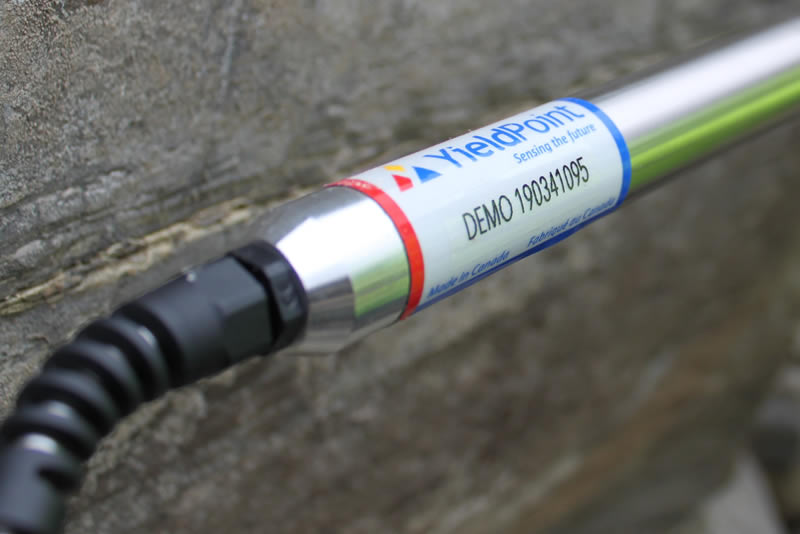YieldPoint’s unique 1 to 6-Point Multiple Rod Extensometer (d-Exto) combines a traditional Multi-Rod design ( robust torsionally straightened stainless steel) and digital signal processing to result in dramatically improved accuracy and reliability compared to similarly priced existing technology. This highly accurate digital instrument comprises up to six (6) Linear Variable Induction Transducers (LVITs) and an on-board digital temperature sensor.
Design features of the d-Exto include a tough fiber glass tube, an internal rubber spacer to ensure that central core which will not be damaged by shear movements of up to 10mm all inside a strong and durable than polyethylene sheath. The hermetically sealed (double potted on request) electronics operate indefinitely when submerged in water.
The inherently digital nature of the signals eliminates the necessity for expensive analog-to-digital conversion and results in low cost readout unit that reads data directly in real world units (mm and oC). The sensor output is an ASCII (9600,8,N,1) digital signal which can be read by a low cost readout unit (d-Reader), dataloggers (BluLink and BluLoggers), and backhauled using (i) Ethernet/Wifi, (ii) LTE-M cellular or (iii) 900MHz(ISM) d-Mesh for transmission to cloud based storage and visualization (VantagePoint).

Features:
- `Super-Tough` design with high strength filament wound fiber glass tube
- Multiple Stainless Steel rods hexagonally packed and maintained straight in fiber glass tube for maximum accuracy.
- 1-6 anchor points
- 150mm (6 inch) stroke length
- High individual sensor accuracy (0.3%FS) and resolution (0.01mm)
- Output in real world units
- Unique instrument ID
- Calibration Coeffs. in Flash memory
- Smallest electronics head (25mm diameter 150mm long)
- On-board digital temperature sensor
- High survivability following blasts and vibration even if toe is damaged
- Easy to install and maintain—Arrives on site fully assembled
Specifications:
- Key Feature: Fully integrated and pre-assembled borehole extensometer
- Dimensions: 25mm diameter can be placed in 50mm hole.
- Dimensions: Up to 6 Anchor points over lengths up to 35m
- Disp. Range (F.S): 125, 150 (standard), 200 and 250mm.
- Disp. Resolution: 0.01mm
- Disp. Accuracy: typically 0.5% F.S(<10m) and 0.25% linearity (>10m). Depends on distance between anchor point and head.
- Temp. Range: -40 to 125 oC
- Temp. Resolution: 0.1C
- Temp Accuracy: +/-1C (inside electronics head)
- Output Signal: RS485 with transmission up to 500m over 2 x tp.
- Output Signal: Asynchronous serial signal – 9600,8,N,1. ASCII encoded. Values and units transmitted.
Datalogging:
Data from the d-EXTO can be collected using YieldPoint’s BluLink, BluLogger and BluGateway (30,000 readings) dataloggers . A population of instruments can be monitored over BT5. The data-loggers require no configuration and are fully interchangeable with any other type of YieldPoint instrument.
Telemetry:
Clusters of (i) wired or (ii) BT5 enbled instruments (4 per BluLogger) can be monitored using d4BluGateway. Wifi/Ethernet or LTE-M BluGateways can autonomously backhaul readings to cloud based storage and visualization platforms (VantagePoint).
Configuration and local data download are provided by the the BluPoint App.
Getting started with Borehole Extensometers
This presentation outlines the essential information required to start using borehole extensometers. Firstly, the basic principles of displacement and strain measurement are introduced. Then different designs of borehole extensometer are described. The displacement sensing technology is briefly discussed. Then a section is presented on the installation best practices, including a discussion of grouts. The toe grouting and breather tube method are discussed.
Case study: Pillar monitoring at 8000ft
As part of CEMI’s UDMN project YieldPoint has been working with Vale Canada’s to monitor a pillar in a hard-rock nickel mine located 8000ft underground in Sudbury, Ontario. A dense deployment of instruments was installed, including Borehole Pressure Cells and optical extensometers in addition to d-EXTO’s. By installing a dense deployment of borehole extensometers the deformation pattern in the pillar could be determined in considerable detail. By interpolating and contouring between instruments, Brad Forbes was able to provide the mine with a frame-by-frame playback of progressive deformation as the mining sequence evolved. A shear zone transecting the instrument array had a dramatic effect of the spatial distribution of deformation. The project team has recently submitted an abstract to the upcoming First International Conference on Underground Mining Technology to be held in Sudbury (Punkkinen et al, 2017). One conclusion is:
“Contouring between adjacent multi-point borehole extensometer measurements has provided an excellent depiction of the pillar behavior as development, using the current face destress procedure, approached a known shear zone.”

